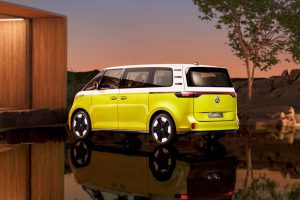E-MOBILITY: The world premiere of the new ID.BUZZ from Volkswagen
A van for the purely electric future: World premiere of the new ID. Buzz
Design: The ID. Buzz transfers seven decades of Bulli know-how into the age of software and digitalisation
Software: Latest version brings state-of-the-art assistance systems such as “Travel Assist with swarm data” and automated parking to the range
Charge: The ID. Buzz can be easily charged on the road with up to 170 kW using “Plug & Charge” technology.
Energy storage: Bidirectional charging (vehicle-to-home) enables ID. Buzz can be integrated into the home energy system.
Space: The ID. Buzz offers space for five people and 1,121 litres of luggage – and as cargo for two Euro pallets.
Market launch: Start in Europe in autumn 2022. Pre-sales will begin in the first countries as early as May
Volkswagen Passenger Cars and Volkswagen Commercial Vehicles presented the new ID. Buzz and ID. Buzz Cargo01 as a world premiere. With Europe’s first purely electrically powered bus and van series, Volkswagen is providing a further answer to sustainable and CO2-free mobility. The ID. Buzz comes with the latest ID. Software and sets new standards in its segment with state-of-the-art systems and functions for safety, comfort and charging.
Ralf Brandstätter, Chairman of the Board of Management of Volkswagen Passenger Cars: “The ID. Buzz is a true icon for the electric age. A car that only Volkswagen can build like this. In the 1950s, the Volkswagen Bulli stood for a new feeling of automotive freedom, independence and great emotion. The ID. Buzz picks up on this attitude to life and transfers it into our time: emission-free, sustainable, fully networked and already ready for the next big chapter – autonomous driving. With this car, we are bringing together the core themes of our ACCELERATE strategy in one product for the first time.”
Carsten Intra, Chairman of the Board of Management of the Volkswagen Commercial Vehicles brand, adds: “Both versions of the ID. Buzz are groundbreaking in terms of their sustainability: they are produced and delivered in a balance sheet-neutral manner in terms of CO2. In addition, recycled plastics are used and the interior is completely animal leather-free.” And further: “The ID. Buzz will also be used in future autonomous mobility concepts such as ridepooling – an e-shuttle service of the Group subsidiary MOIA that can be booked via app. So the electric Bulli is also part of the future of inner-city transport.”
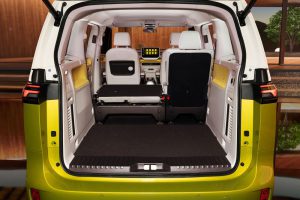
Like all models in the ID. Family from Volkswagen Passenger Cars, the ID. Buzz built by Volkswagen Commercial Vehicles in Hanover is technically based on the Group’s modular e-drive system (MEB). The world’s first scalable large-scale production platform for pure electric cars provides the basis for a wide range of models and segments across all brands. Its architecture allows for the evolutionary further development of software and technology, from which both new models such as the ID. Buzz as well as models already delivered can benefit from over-the-air updates.
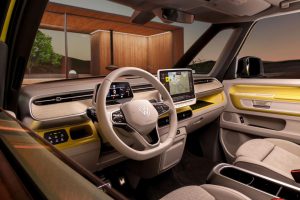
ID. Software of the latest generation with new assistance and charging functions. The assistance systems of the new series perfect comfort and safety. For example, the ID. Buzz and ID. Buzz Cargo are equipped with the local warning system “Car2X”, which uses signals from other vehicles and the traffic infrastructure to detect dangers in real time. Also standard: the “Front Assist” emergency braking system and, in the minibus, the “Lane Assist” lane departure warning system. With new software, new assistance functions also find their way into the ID. Family: The “Travel Assist with Swarm Data” is available as an option, which enables semi-automated driving over the entire speed range and, for the first time, an assisted lane change on the motorway. Also new: the “Memory Function” for automated parking on a previously saved route.
Up to 170 kW charging power, Plug & Charge and bidirectional charging.
Across Europe, the ID. Buzz and the ID. Buzz Cargo will be launched with a 77 kWh battery (gross energy content: 82 kWh). It supplies power to a 150 kW electric motor, which – like the boxer engine in the T1 – drives the rear axle. The battery, which is integrated deep down in the sandwich floor, and the lightweight e-drive result in good weight distribution and a low centre of gravity. Both factors optimise handling and agility. The lithium-ion battery is charged at wallboxes and public charging points with 11 kW alternating current (AC). Using a CCS plug at a DC fast charging station (direct current), the charging power increases to up to 170 kW; the battery is thus charged from 5 to 80 percent after around 30 minutes. The series will also be equipped with the latest ID. Software, the series will also offer the “Plug & Charge” function in future. In this case, the ID. Buzz authenticates itself via the charging plug at compatible DC fast charging stations with the ISO 15118 standard and thus exchanges all necessary data with the charging point – a convenience plus. Bidirectional charging enables the ID. Buzz to feed unneeded energy from the battery into the customer’s home network (vehicle-to-home). Power transfer and communication take place via a special DC-BiDi wallbox.
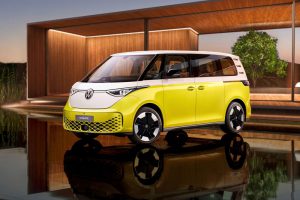
Iconic design: The ID. Buzz is the new face of sustainable mobility. The unique design of the ID. Buzz forms the visual bracket around the forward-looking technologies. Buzz. “The T1 – an icon of the 1950s – gave people mobility and freedom. With the ID. Buzz, we are transferring this T1 DNA into the present day and thus into the era of electric mobility,” outlines Jozef Kabaň, Head of Volkswagen Design. “The ID. Buzz brings a lot of sympathy and closeness to people back onto the road,” the chief designer continues. And it is the proportions that make the ID. Buzz so unique. Kabaň builds a bridge to the classic: “With the T1, I’m practically sitting on the front axle – no front overhang. For all its safety relevance and technology, the ID. Buzz has super short overhangs.” The designer sums up: “The ID. Buzz is timeless, sustainable and yet extremely functional – that’s what makes it unique.” The iconic front section with its v-shaped bonnet between the charismatic LED headlights has also always been typical of the series. This also applies to the optional two-tone paint finish.
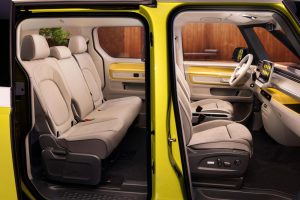
Friendly, spacious interior for a life on the move. Drivers and passengers of the ID. Buzz experience the new Bulli feeling in a generously designed interior. Typical Bulli: the layout is very clear, the concept well thought-out and the use of space optimal: five people have plenty of room to travel and for their luggage (1,121 litres capacity) in the lounge-like, friendly ambience of the bus version. If the second row of seats is folded down, the load volume increases to up to 2,205 litres. Depending on the choice, two or three seats in the front and a fixed partition to the 3.9 m3 load compartment characterise the ID. Buzz Cargo. The zero-emission transporter can take two Euro pallets loaded crosswise.
Long wheelbase, compact body, maximum utilised traffic area. The ID. Buzz and the ID. Buzz Cargo are characterised by a long wheelbase of 2,988 mm, which is roughly the same as the current T6.1. The length of both versions is 4,712 mm. Due to the very large wheelbase in relation to the overall length, the traffic area is optimally used. Both versions of the ID. Buzz measure between 1,937 mm and 1,938 mm in height, including the roof antenna, depending on the equipment. At 1,985 mm, the new model is 81 mm wider than a T6.1. The turning circle of 11.1 metres, however, is unusually small.
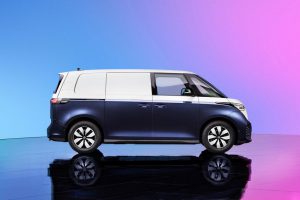
The first bus with the cw value of a car. Even with the T1, the first Bulli, design followed function. Form follows function – this central tenet of automotive design also applies to the design of the ID. Buzz. The iconic, clear forms are juxtaposed with outstanding aerodynamics: The ID. Buzz has a cd value of 0.285, the ID. Buzz Cargo has a cd value of 0.29. This reduces energy consumption and increases the range.
Made in Germany. The ID. Buzz series is produced by Volkswagen Commercial Vehicles at its main plant in Hanover. The majority of the electric drive modules supplied there will also be manufactured in Germany to the highest quality standards – in this case by the independent Group division Volkswagen Group Components. Since 2022, the Hanover plant has been one of the Group’s high-tech locations for the production of fully electric vehicles. Generally speaking, Volkswagen Commercial Vehicles has also started a transformation process in order to be able to offer more electrified models in the future. Where a Bulli series was once produced in Hanover, three Bulli product lines are now being built in parallel – two of them electrified. As zero-emission vehicles, the ID. Buzz and the ID. Buzz Cargo leave the production line as zero-emission vehicles – they bear witness to a mobility decision with which their owners can meet the climatic challenges of our time.
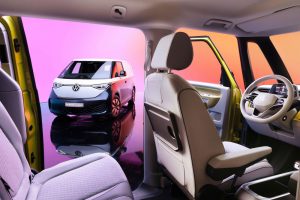
European pre-sales start in May, market launch in autumn. The ID. Buzz and the ID. Buzz Cargo will be launched in the first European countries in autumn this year; the pre-sales start is already planned for May. With the ID. Buzz will mark the comeback of the so-called microbus in the USA and Canada.
BRAND: Volkswagen AG
virtualdesignmagazine Michael Hiller


